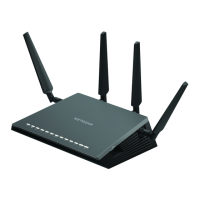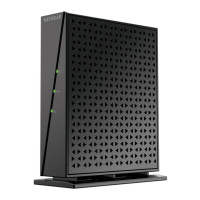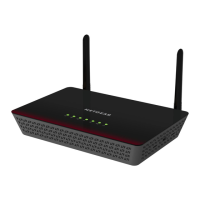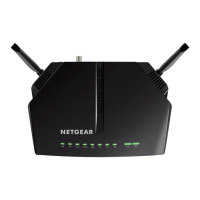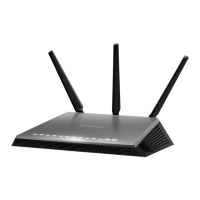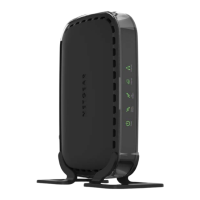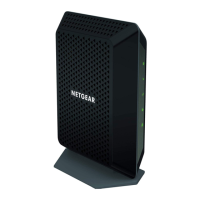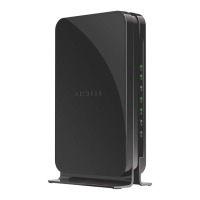Do you have a question about the NETGEAR D7000 and is the answer not in the manual?
| Ethernet LAN | Yes |
|---|---|
| Cabling technology | 10/100/1000Base-T(X) |
| Networking standards | IEEE 802.11a, IEEE 802.11ac, IEEE 802.11b, IEEE 802.11g, IEEE 802.11n, IEEE 802.3, IEEE 802.3ab, IEEE 802.3u |
| Ethernet LAN data rates | 10, 100, 1000 Mbit/s |
| Ethernet LAN interface type | Gigabit Ethernet |
| Modulation | PSK |
| Wi-Fi band | Dual-band (2.4 GHz / 5 GHz) |
| Wi-Fi standards | 802.11a, Wi-Fi 5 (802.11ac), 802.11b, 802.11g, Wi-Fi 4 (802.11n) |
| Top Wi-Fi standard | Wi-Fi 5 (802.11ac) |
| WLAN data transfer rate (max) | 1300 Mbit/s |
| Memory card slot(s) | No |
| Ethernet LAN (RJ-45) ports | 5 |
| USB 3.2 Gen 1 (3.1 Gen 1) Type-A ports quantity | 3 |
| DSL specification | VDSL, VDSL2, ADSL, ADSL2, ADSL2+ |
| Web-based management | - |
| Firewall security | SPI, NAT |
| Security algorithms | WPA, WPA2-PSK, WPS |
| Product type | Tabletop router |
| Product color | Black |
| Housing material | Plastic |
| Flash memory | 128 MB |
| Internal memory | 256 MB |
| Processor cores | 2 |
| Processor frequency | 1000 MHz |
| Windows operating systems supported | Windows 2000, Windows 7, Windows 8, Windows Vista, Windows XP |
| Cables included | LAN (RJ-45), Phone (RJ-11) |
| Supported network protocols | IPv6 |
| Power source type | AC |
| Package type | Box |
| Depth | 185 mm |
|---|---|
| Width | 285 mm |
| Height | 50 mm |
| Weight | 750 g |
Details on the contents of the modem router package and what to expect in the box.
Instructions for attaching the modem router's antennas for optimal WiFi performance.
Description of the status LEDs and buttons located on the modem router's top panel.
Overview of the modem router's back panel components, including ports, buttons, and switches.
Information about the location and function of the USB 3.0 ports on the modem router's side panels.
Details about the information found on the modem router's bottom panel product label.
Guidelines for optimal placement of the modem router to ensure good WiFi signal range and performance.
Methods for connecting a computer to the modem router via Ethernet cable or WiFi.
Step-by-step instructions for configuring the modem router for DSL Internet service.
Step-by-step instructions for configuring the modem router for Cable or Fiber Internet service.
Procedure for accessing the modem router's web interface to view or modify settings.
Instructions for changing the default administrator password for enhanced security.
Steps to enable password recovery options for the modem router's administrator account.
Procedure for allowing the modem router to automatically check for and install firmware updates.
Guide to using the NETGEAR genie app for managing the modem router's network features.
Guide to using the setup wizard for automatic configuration of Internet connection settings.
Detailed steps for manually configuring ADSL Internet connection parameters.
Detailed steps for manually configuring VDSL Internet connection parameters.
Detailed steps for manually configuring Cable or Fiber Internet connection parameters.
Instructions for manually configuring various types of IPv6 Internet connections.
Guidance on adjusting the Maximum Transmission Unit (MTU) size for optimal network performance.
Configuration of SSID, security type, and passphrase for the primary WiFi network.
Steps to connect devices to the WiFi network using WPS push button or PIN methods.
Setup and configuration of a separate guest WiFi network for visitors.
Options to enable, disable, or schedule the operation of the modem router's WiFi radios.
Procedure to schedule the automatic turn-on and turn-off of WiFi signals.
Configuration options for Wi-Fi Protected Setup (WPS), including PIN management.
Configuration of advanced WiFi parameters such as fragmentation length and CTS/RTS threshold.
Instructions to configure the modem router to function as a WiFi access point (AP).
Configuration of parental controls to filter content and manage internet access for specific devices.
Managing network access control by specifying MAC addresses to allow or block devices.
Blocking access to specific websites or content using keywords and domain names.
Creating outbound firewall rules to control access to specific services or applications.
Setting up a schedule for when keyword blocking and outbound firewall rules are active.
Configuring the modem router to send email alerts for security events.
Using Quality of Service (QoS) to prioritize Internet traffic for applications and services.
Adding, changing, or removing Quality of Service (QoS) rules for traffic management.
Enabling or disabling beamforming to improve WiFi range and performance.
Configuring UPnP settings to facilitate network device discovery and access.
Specifications and compatibility information for USB storage devices supported by the modem router.
Instructions for physically connecting a USB storage device to the modem router's USB ports.
Methods for accessing files on a connected USB storage device from Windows or Mac computers.
Using ReadySHARE Vault software for automatic backup of Windows computers to a USB device.
Configuring access methods (HTTP, FTP, HTTPS) and permissions for shared USB storage devices.
Procedure for safely disconnecting a USB device from the modem router to prevent data loss.
Configuring Dynamic DNS to access the network using a domain name, even if the IP address changes.
Guidelines for accessing connected USB storage devices remotely via the Internet.
Enabling and configuring FTP access to share files on USB devices over the Internet.
Configuring the modem router to function as a DLNA media server for media playback.
Steps to play music from a connected USB storage device using iTunes Server.
Instructions for setting up the modem router to work with TiVo for media playback.
Prerequisites and steps for installing printer drivers and connecting a USB printer.
Information on obtaining the ReadySHARE Printer utility for Windows, Mac, and mobile devices.
Procedures for connecting to and printing using a shared USB printer via the NETGEAR utility.
Customizing settings for the NETGEAR USB Control Center, including automatic startup and language.
Selecting between DSL or Ethernet WAN ports for the modem router's Internet connection.
Setting up Virtual LANs (VLANs) to segment network traffic for Internet and IPTV services.
Configuring bridge mode for the virtual IPTV interface to allow direct connection for IPTV devices.
Configuring WAN security features like port scan and DoS protection, and responding to pings.
Configuring a default DMZ server to bypass firewall protection for specific applications or games.
Adjusting Network Address Translation (NAT) filtering settings between Secured and Open modes.
Changing the modem router's default LAN IP address and subnet mask.
Assigning static IP addresses to devices on the LAN via DHCP address reservation.
Disabling the modem router's DHCP server and configuring manual IP settings on computers.
Checking for and installing new firmware to update the modem router's software.
Saving and restoring modem router configuration settings to a file.
Steps to recover the administrator password if it is forgotten, provided password recovery was set up.
Resetting the modem router to its original factory default configuration settings.
Customizing the behavior of the modem router's LEDs, such as disabling blinking or turning them off.
Viewing information about the modem router's ports, Internet connection, and WiFi network status.
Monitoring and viewing traffic statistics for the modem router's ports.
Using the traffic meter utility to monitor and control Internet traffic volume and connection time.
Recording and restricting Internet traffic based on data volume limits per month.
Recording and restricting Internet traffic based on connection time limits.
Procedure to unblock the traffic meter after a volume or time limit has been reached.
Configuring secure remote access to the modem router's settings over the Internet.
Changing the modem router's operation mode to function solely as a DSL modem.
Steps to establish a secure VPN connection between a computer and the modem router.
Configuring the modem router's VPN service settings, including protocol and port.
Installation guide for the OpenVPN client software on Windows operating systems.
Installation guide for the OpenVPN client software on Mac OS X operating systems.
Configuring VPN to access your home Internet service remotely, bypassing local ISP limitations.
Setting up rules to forward incoming Internet traffic to specific local servers or applications.
Creating custom port forwarding rules for services not predefined in the modem router.
Modifying existing port forwarding rules for services or applications.
Deleting port forwarding rules that are no longer needed.
Configuring port triggering rules to dynamically open incoming ports based on outbound traffic.
Defining custom port triggering rules for specific services or applications.
Modifying existing port triggering rules.
Deleting port triggering rules that are no longer required.
Setting the duration for which inbound ports remain open in port triggering rules.
Running diagnostic tests like DNS lookup and ping to identify network issues.
Procedure for remotely rebooting the modem router through its web interface.
Basic troubleshooting steps for common network and modem router issues.
Interpreting the status of the modem router's LEDs to diagnose operational problems.
Troubleshooting steps for issues preventing access to the modem router's web interface.
Steps to diagnose and resolve problems with the modem router's Internet connectivity.
Troubleshooting steps when configuration changes made in the web interface are not saved.
Steps to resolve issues with connecting to the modem router's WiFi network.
Using the ping utility to test network connectivity and diagnose communication problems.
Table detailing the default factory settings for the modem router's features and configurations.
Detailed technical specifications of the modem router, including hardware, protocols, and dimensions.
